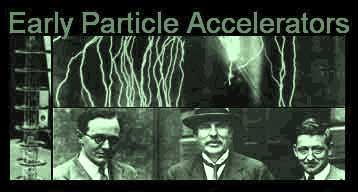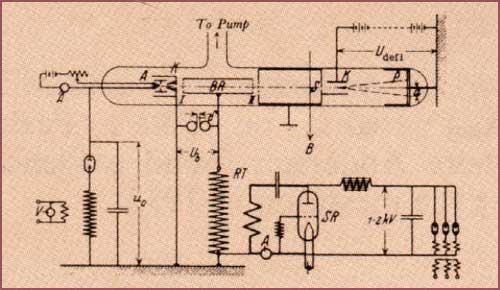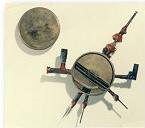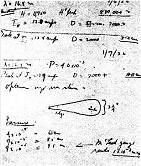

|
The Cockcroft-Walton Accelerator
|
||||
|
Right: Rolf Wideröe's diagrams describing a method for accelerating ions inspired Ernest Lawrence's invention of the cyclotron. |

|
|
|
|
Lawrence soon brought David Sloan to Berkeley. He was a young expert in electronics from the General Electric Laboratories in Schenectady with experience in handling high voltages. While Lawrence was building the cyclotron, Sloan pursued Wideröe's linear accelerator. Sloan's device eventually had a series of thirty electrodes. By May 1931 it accelerated mercury ions to energies of a million volts. This work gave Lawrence and his students experience with oscillators and beam focusing, knowledge they would later apply to cyclotrons. Sloan, however, put the linear accelerator aside to develop a resonant transformer, which turned out to provide a powerful source of X-rays which was of great interest to hospitals. |
The Cyclotron
|
|
Shallow
metal half-cyclinders, later called "dees" after their shape, serve as electrodes;
charged particles injected into the gap near the center are pulled by the
potential into the electrode A; the magnetic field, perpendicular to the
plane of the cylinders, bends them in a semicircle back into the gap; in
the meantime the electric field has reversed and can pull them into electrode
B; whence they emerge again in step with the electric field; and so on,
eventually spiraling out to the edge. Each passage through the gap boosts
the particles to higher energies.
|
|
Putting the plan into practice, however, meant facing daunting obstacles. It required vacuum seals that could withstand the stresses of the alternating electric field and the magnet. Too poor a vacuum and the circulating particles might be bumped from their paths by air molecules. The particles might also go astray crossing the gap or, what would be the hardest problem, deviate from the horizontal plane of their orbits and crash into the floor or ceiling of the electrodes. |
 The first successful cyclotron, the 4.5-inch model built by Lawrence and Livingston. |
Lawrence bypassed these obstacles with the help of two cut-and-try discoveries. The first was to remove a metal grid from the entrance to the dees, which he had thought necessary for electrical shielding. Sloan's work had demonstrated that instead it interfered with focusing by the electric field that kept particles in the horizontal plane. The second trick was to insert small iron shims into the magnetic field to coax particles back into the orbital plane. A bit of tinkering gave Lawrence his million-volt projectiles.
|
 An early sketch from Lawrence's notebook of a shim for the 11-inch cyclotron. |
| Back |